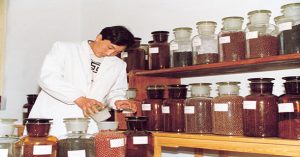India and China have both nominated Tibetan medicine, known as Sowa-Rigpa, to be included in UNESCO’s list of Intangible Cultural Heritage.
Sowa-Rigpa is among the oldest documented medical traditions in the world, with records of its existence dating back to the 3rd century BC. Early practitioners would apply residual barley from chang[a Tibetan barley beer] onto swollen body parts, drink hot water for indigestion, and use melted butter for bleeding. These techniques gradually formed the basis of the art of healing in Tibet over many centuries. The fundamental medical text of the Tibetan medical heritage is the Book of the Four Tantras.
The rival nominations have caused quite a stir.

Tibetan Medicine Capsules
Photo: Gao Guorong
Tsering Phuntsok, Registrar of the Tibetan Medical and Astrological Institute (TMAI) based in Dharamshala, objected to the nomination on the grounds that there was nothing “intangible” about Tibetan Medicine. “The Tibetan Sowa-Rigpa tradition is a science, no less a science that has healed and continues to heal countless chronic and sometimes terminal patients over the years, how is it ‘intangible’?” He added, “The Director [of TMAI] has made it abundantly clear that categorising Tibetan medicine as intangible will never be accepted by the institute”.
Professor Geshe Ngawang Samten, the Vice-Chancellor of the Central Institute of Higher Tibetan Studies in Varanasi, backed the Indian nomination, saying “even though Sowa-Rigpa originated in Tibet, it is a part of Indian culture as it has been practiced here for more than a millennium. Also, it has a lot of influences of Ayurveda”. However, of the Chinese bid he said. “There was talk that China is going to write to UNESCO calling Sowa-Rigpa a Tibetan-Chinese medical system. Now, there is no such nomenclature as ‘Tibetan-Chinese’. Either it is Tibetan or it is Chinese”.

TMAI products
Photo: Phayul
Throughout the Mao era there were myths that Tibetan medicine contained a lot of mercury and lead. Consequently, during the Chinese Cultural Revolution in the 1960s and 70s, Tibetan medicine institutions were destroyed by Chinese soldiers and doctors were imprisoned. Subsequent revival efforts led by His Holiness the Dalai Lama from exile have been successful. The practice survived and is now “a well integrated medical science, recognised by the western doctors and scientists” said Tashi Tsering Phuri, the Director of TMAI.




 Print
Print Email
Email